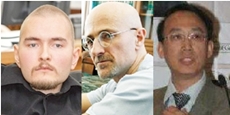Maverick Italian, Chinese docs set to attempt first head transplant
31 Aug 2016
Valery Spiridonov, 31, is a Russian tech geek who runs an educational software company from his home east of Moscow. Because he has Werdnig-Hoffmann disease, a genetic disorder that wastes muscles and motor neurons, he is physically capable of little beyond feeding himself, steering his wheelchair with a joystick, and typing. The disease is usually fatal, and doctors expected him to be dead by now.
 | |
| Valery Spiridonov (Left), Sergio Canavero and Xiaoping Ren |
Xiaoping Ren, 55, is a Chinese surgeon who, when he lived in the United States, was on the team that performed the first successful hand transplant. He practiced for it by switching pigs' forelegs, and he keeps in his office a bronze pig ear that the transplant team sent him as a trophy.
And Sergio Canavero, 51: a shaven-headed, flamboyant Italian neurosurgeon who compares himself to Dr Frankenstein, mentions notorious Nazi doctor Josef Mengele and has written not only dozens of respected scientific papers but also a guide to seducing women. In 2013, he announced he wanted to try to transplant a human head.
You might see where this is leading. Canavero and Ren want to perform the world's first head transplant, and Spiridonov has volunteered.
Sam Kean's story about the project, published in the Atlantic magazine, is deeply weird. Canavero says the transplant could happen as early as 2017 and has a "90 per cent plus" chance of success. If it does take place, it would require 80 surgeons and cost tens of millions of dollars.
Many scientists and ethicists have derided the project as "junk science" that raises false hopes. One says that if Spiridonov dies - a not unlikely outcome - the doctors should be prosecuted for murder.
Kean weaves in history, science and entertaining detail; doctors would colour-code the severed muscles of Spiridonov and the brain-dead body donor, to make reattachment easier; the surgery would be done with a transparent diamond blade; the procedure probably would take place in China because it is not likely to be approved in the United States or Europe.
And the story raises interesting questions. Even if Ren and Canavero can do the surgery, should they? If the donor body belonged to a pianist, would its muscle memory enable Spiridonov to play the piano? Who would the surviving patient be - Spiridonov or some kind of amalgam?
Time will answer these, and more, questions.
Dr Canavero and Spiridinov have not yet met and have only communicated via Skype so far, but they have reportedly been discussing the operation for two years.
Spiridinov says the date has not yet been agreed, but pending ongoing studies, it could be as soon as this year.
''This technology is similar to the first man to walk in space. This is because in the future it will help thousands of people who are in an even more deplorable state than I am,'' he says.
Dr Canavero has not yet secured funding for the 150-strong medical team he would require for the €7.5-million operation.
Doomed to failure?
Despite Spiridinov's optimism much of the medical profession believe the controversial procedure is doomed.
Dr Hunt Batjer, president-elect of the American Association for Neurological Surgeons, told CNN, ''I would not wish this on anyone. I would not allow anyone to do it for me as there are a lot of things worse than death.''
Head transplants have been carried out on dogs, monkeys and mice, all with varying degrees of success.
Chinese scientists have carried out a head transplant on a mouse. Owing to which, there are some models for the procedure. But a majority of experts affirmed that a human head transplant is a complete unexplored thing.
Gory-sounding procedure
Describing the process, Dr Canavero said the first thing he would have to do was to cool both the body and head, so that the cells would not die when they are deprived of oxygen during the process.
In the next phase, the neck of patient will be cut and all the important blood vessels will be hooked up to tubes. Meanwhile, the spinal cord on the head and the body will be severed. The next step would be move the recipient's head onto the donor's body and the two ends of the spinal cord are joined together.
The last stage of this lengthy surgery would be stitch up the muscles and blood supply.






.webp)















